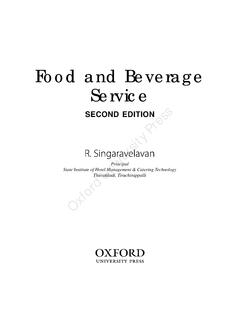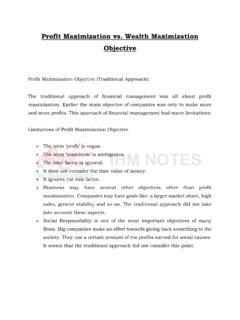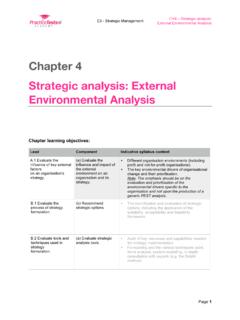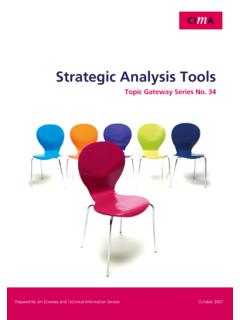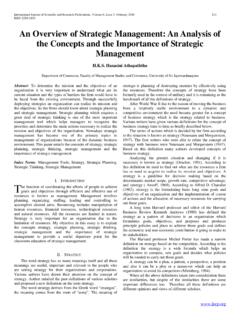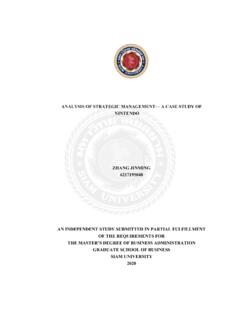Transcription of CHAPTER 4. STRATEGIC ANALYSIS AND CHOICE …
1 CHAPTER 4. STRATEGIC ANALYSIS AND CHOICE (ALLOCATION OF RESOURCES) Strategy ANALYSIS and CHOICE is a process that reconciles STRATEGIC actions, market opportunities, corporate strengths and resources, values of managers, and legal requirements and social responsibilities to select a "best" mission, STRATEGIC thrust, and set of STRATEGIC actions. Strategy formulating techniques can be integrated into a three-stage decision making frame work. INTERNAL FACTOR EVALUATION MATRIX (IFE) Internal Factor Evaluation (IFE) matrix is a STRATEGIC management tool for auditing or evaluating major strengths and weaknesses in functional areas of a business. The IFE Matrix together with the EFE matrix is a strategy-formulation tool that can be utilized to evaluate how a company is performing in regards to identified internal strengths and weaknesses of a company.
2 The IFE matrix method conceptually relates to the Balanced Scorecard method. How to create the IFE matrix? The IFE matrix can be created using the following five steps: 1. Key internal Conduct internal audit and identify both strengths and weaknesses in all your business areas. Identify 10 to 20 internal factors, but the more you can provide for the IFE matrix, the better. It is wise to be as specific and INPUT STAGE MATCH STAGE DECISIVE STAGE objective as possible. (You can for example, express in percentages, ratios, and comparative numbers.) 2. Having identified strengths and weaknesses, the core of the IFE matrix, assign a weight that ranges from 0 to 100 scale .After you assign weight to individual factors, make sure the sum of all weights equals 100.
3 The weight assigned to a given factor indicates the relative importance of the factor to being successful in the firm's industry. Weights are industry based. 3. Assign a 1 to 4 rating to each factor. Your rating scale can be per your preference. If you use the rating scale 1 to 4, then strengths must receive a 4 or 3 rating and weaknesses must receive a 1 or 2 rating. Rating 1=a major weakness. Rating 2 = a minor weakness. Rating 3=a minor strength. Rating 4= a major strength. Note: the weights determined in the previous step are industry based. Ratings are company based. 4. Now we can get to the IFE matrix math. Multiply each factor's weight by its rating. This will give you a weighted score for each factor. 5. The last step in constructing the IFE matrix is to sum the weighted scores for each factor.
4 This provides the total weighted score for your business. Example of IFE matrix The following table provides an example of an IFE matrix. Weights times ratings equal weighted score. What values does the IFE matrix take? Regardless of how many factors are included in an IFE Matrix, the total weighted score can range from a low of to a high of (assuming you used the 1 to 4 rating scale). The average score you can possibly get is weighted scores well below point to internally weak business. Scores significantly above indicate a strong internal position. It is important to note that a thorough understanding of individual factors included in the IFE matrix is still more important than the actual numbers. EXTERNAL FACTOR EVALUATION MATRIX (EFE) External Factor Evaluation (EFE) matrix method is a STRATEGIC -management tool often used for assessment of current business conditions.
5 The EFE matrix is a good tool to visualize and prioritize the opportunities and threats that a business is facing. The EFE matrix is very similar to the IFE matrix. The major difference between the EFE matrix and the IFE matrix is the type of factors that are included in the model. While the IFE matrix deals with internal factors, the EFE matrix is concerned solely with external factors. External factors assessed in the EFE matrix are the ones that are subjected to the will of social, economic, political, legal, and other external forces. How to create the EFE matrix? 1. List The first step is to gather a list of external factors. Divide factors into two groups: opportunities and threats. 2. Assign Assign a weight to each factor. The value of each weight should be between 0 and 100. The total value of all weights together should equal 1 or 100.
6 3. Rate Assign a rating to each factor. Rating should be between 1 and 4. Rating indicates how effective the firm s current strategies respond to the factor. 1 = the response is poor. 2 = the response is below average. 3 = above average. 4 = superior. Note: the weights determined in the previous step are industry based. Ratings are company based. 4. Multiply weights by Multiply each factor weight with its rating. This will calculate the weighted score for each factor. 5. Total all weighted Add all weighted scores for each factor. This will calculate the total weighted score for the company. EFE matrix example Total weighted score of indicates that the business has slightly less than average ability to respond to external factors. What should I include in the EFE matrix? Now that we know how to construct or create the EFE matrix, let's focus on factors.
7 External factors can be grouped into the following groups: Social, cultural, demographic, and environmental variables: Economic variables Political, government, business trends, and legal variables Below you can find examples of some factors that capture aspects external to your business. (Not all apply to a business, but one can use this listing as a starting ) - Aging population, Per-capita income, Education - Trends in housing, shopping, careers, business - Number of births and/or deaths - Immigration & emigration rates Economic - Growth of the economy - Level of savings, investments, and capital spending - Inflation - Foreign exchange rates - Stock market trends - - Product life cycle ..etc COMPETITIVE MATRIX Definition: A chart that compares your product or service to your competitor(s) A competitive matrix is an ANALYSIS tool that helps you establish your company's competitive advantage.
8 It provides an easy-to-read portrait of your competitive landscape and your position in the marketplace. The matrix can be just a simple chart. In the left column, you list the main features and benefits of your product or service. On the top row, you list your company and the names of your competitors. Then fill in the chart with the appropriate information for each company. For example, if you own a dry cleaning service, you might list the different services you offer or the quick turnaround you provide on items (24 hours), and then note how your competitors fail at these features. The matrix can be shared with customers as a sales tool, or you can develop the matrix solely for in-house purposes to keep abreast of the competition. Internal-External (IE) matrix The Internal-External (IE) matrix is another STRATEGIC management tool used to analyze working conditions and STRATEGIC position of a business.
9 The Internal External Matrix or short IE matrix is based on an ANALYSIS of internal and external business factors which are combined into one suggestive model. The IE matrix is a continuation of the EFE matrix and IFE matrix models. How does the Internal-External IE matrix work? The IE matrix belongs to the group of STRATEGIC portfolio management tools. In a similar manner like the BCG matrix, the IE matrix positions an organization into a nine cell matrix. The IE matrix is based on the following two criteria: 1. Score from the EFE matrix -- this score is plotted on the y-axis 2. Score from the IFE matrix -- plotted on the x-axis The IE matrix works in a way that you plot the total weighted score from the EFE matrix on the y axis and draw a horizontal line across the plane. Then you take the score calculated in the IFE matrix, plot it on the x axis, and draw a vertical line across the plane.
10 The point where your horizontal line meets your vertical line is the determinant of your strategy. This point shows the strategy that your company should follow. On the x axis of the IE Matrix, an IFE total weighted score of to represents a weak internal position. A score of to is considered average. A score of to is strong. On the y axis, an EFE total weighted score of to is considered low. A score of to is medium. A score of to is high. IE matrix Let us take a look at an example. We calculated IFE matrix for an anonymous company on the IFE matrix page. The total weighted score calculated on this page is which points at a company with an above-average internal strength. We also calculated the EFE matrix for the same company on the EFE matrix page.

